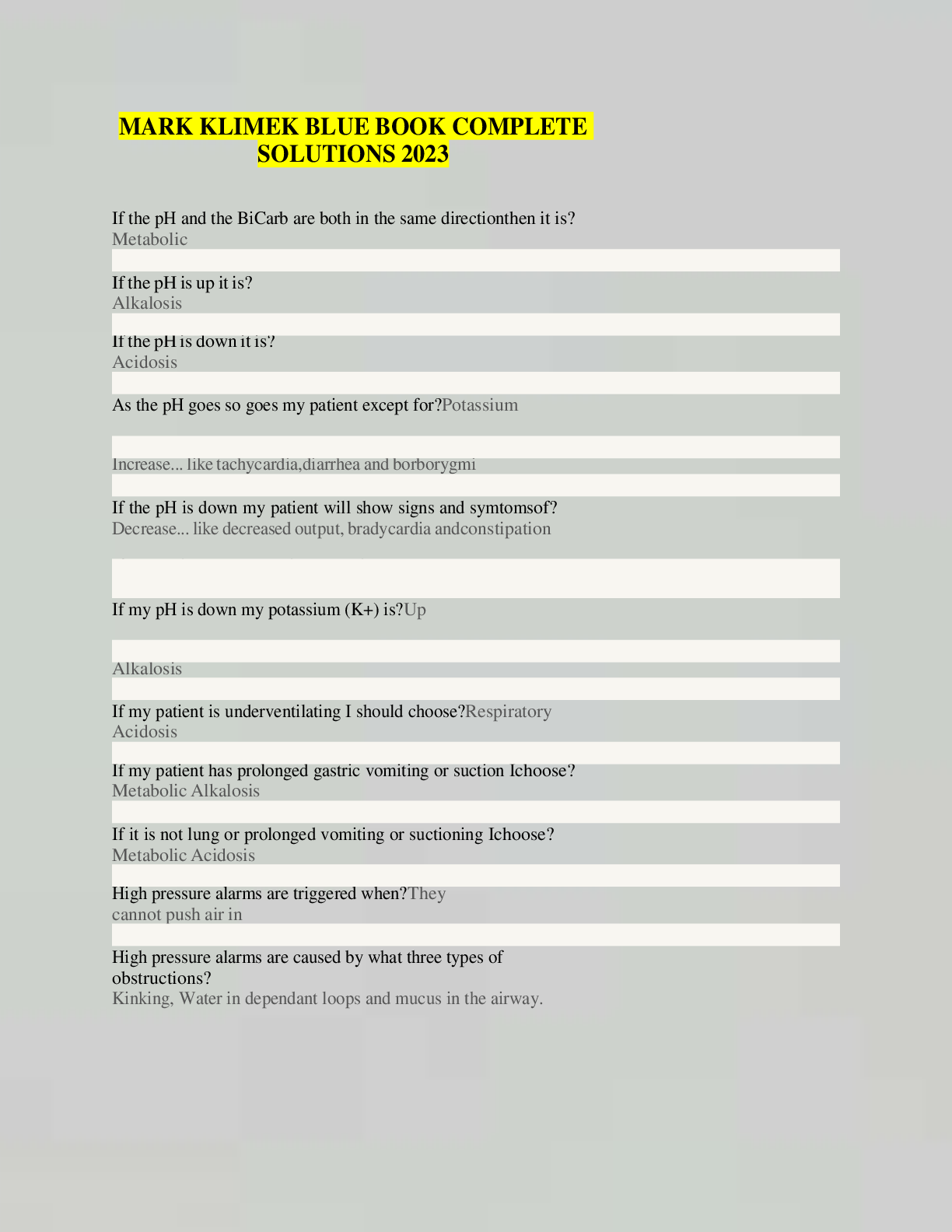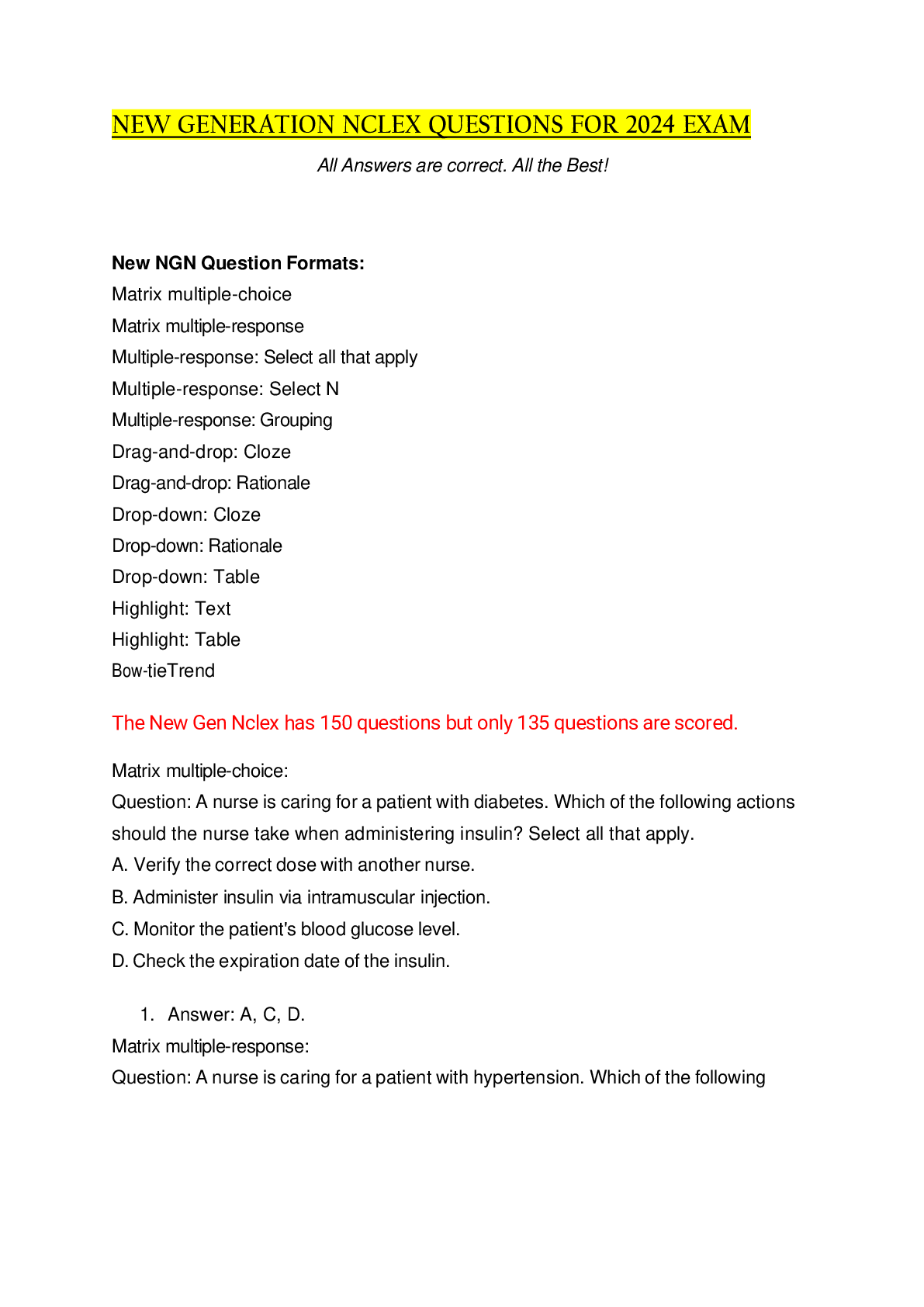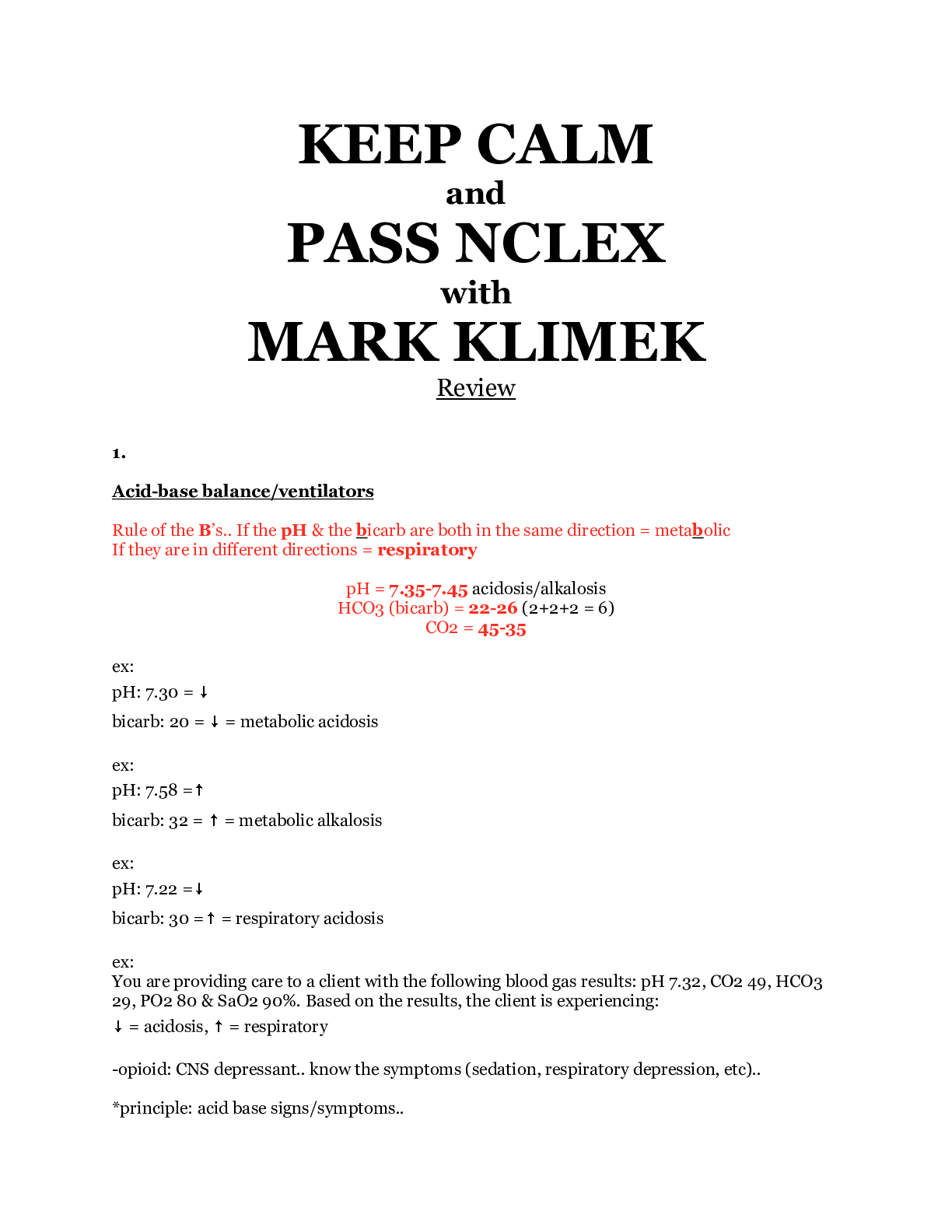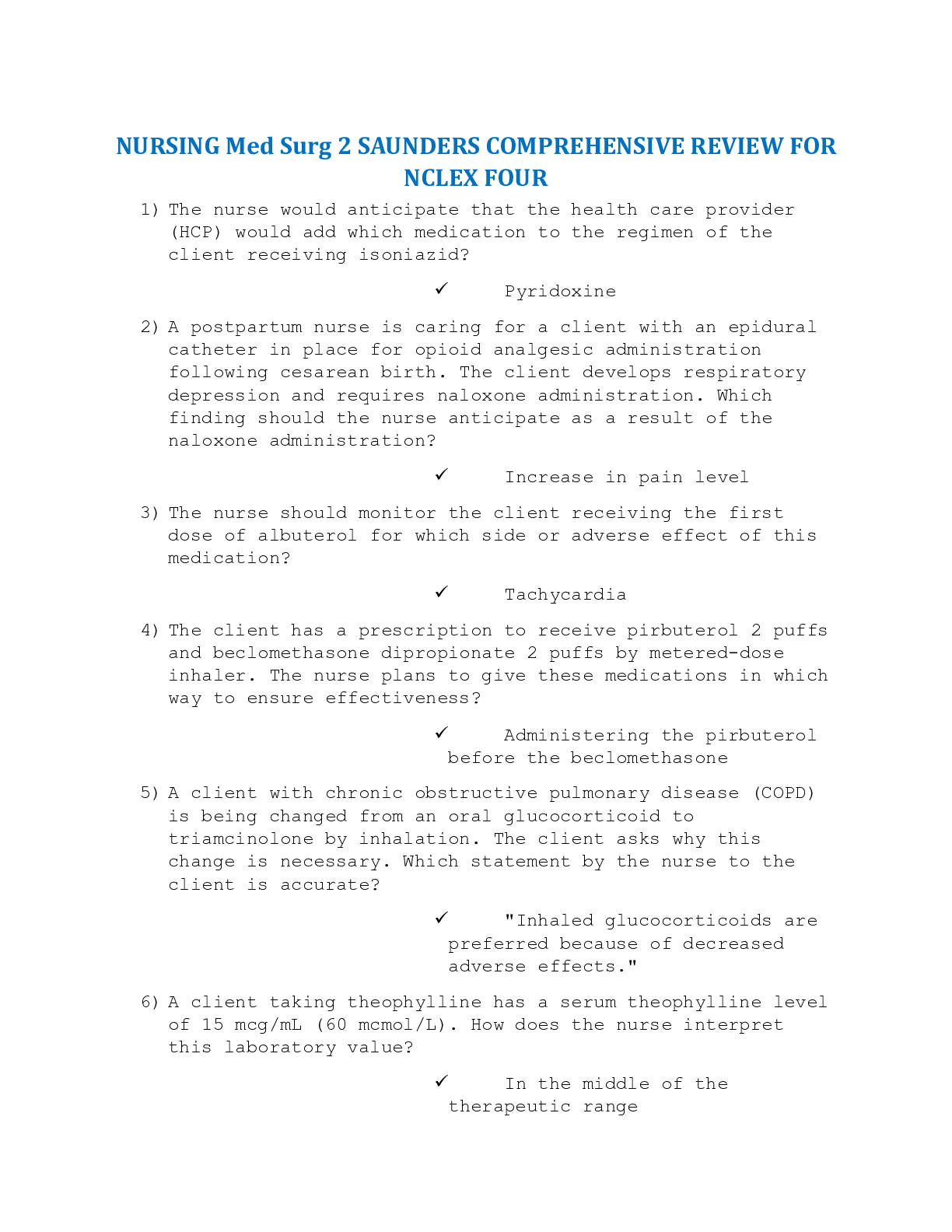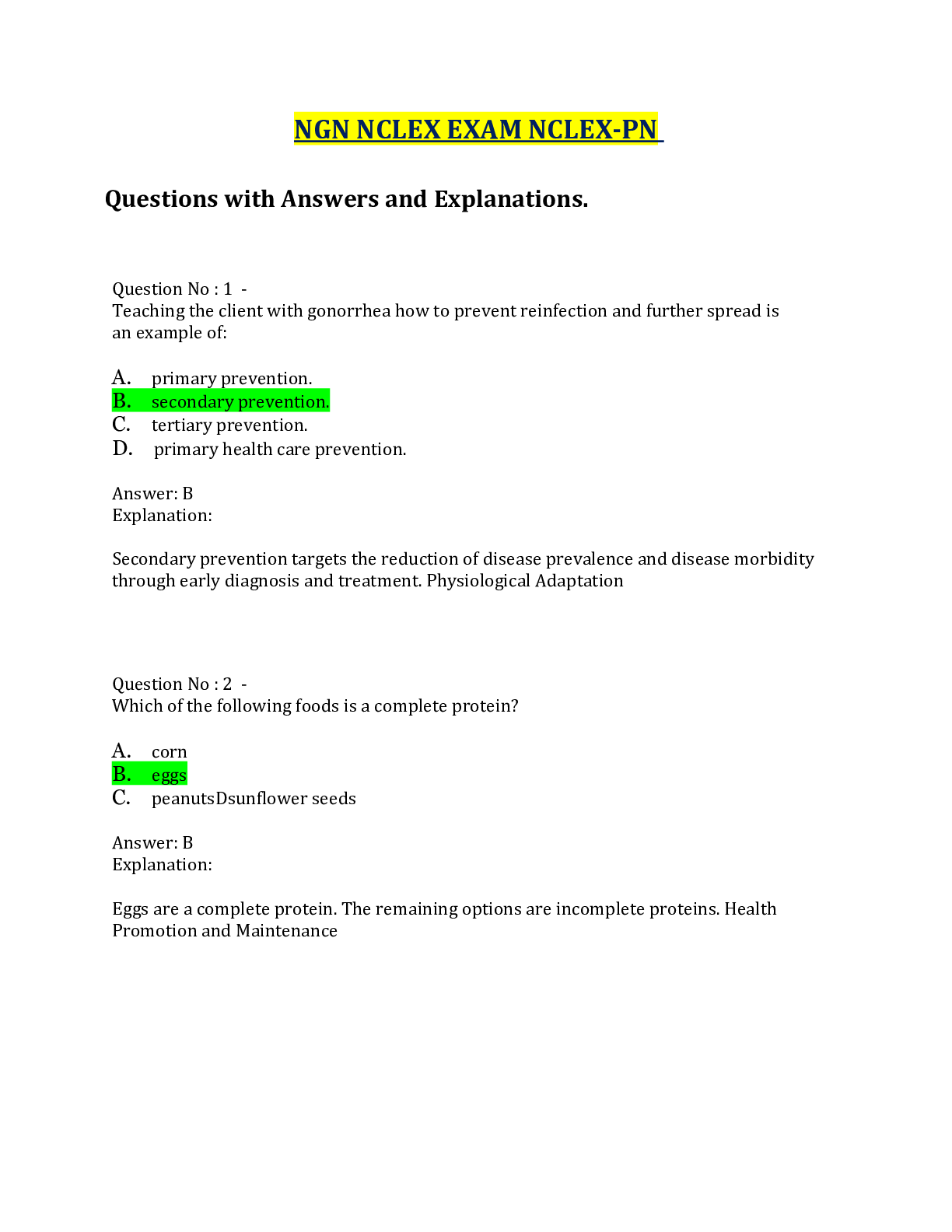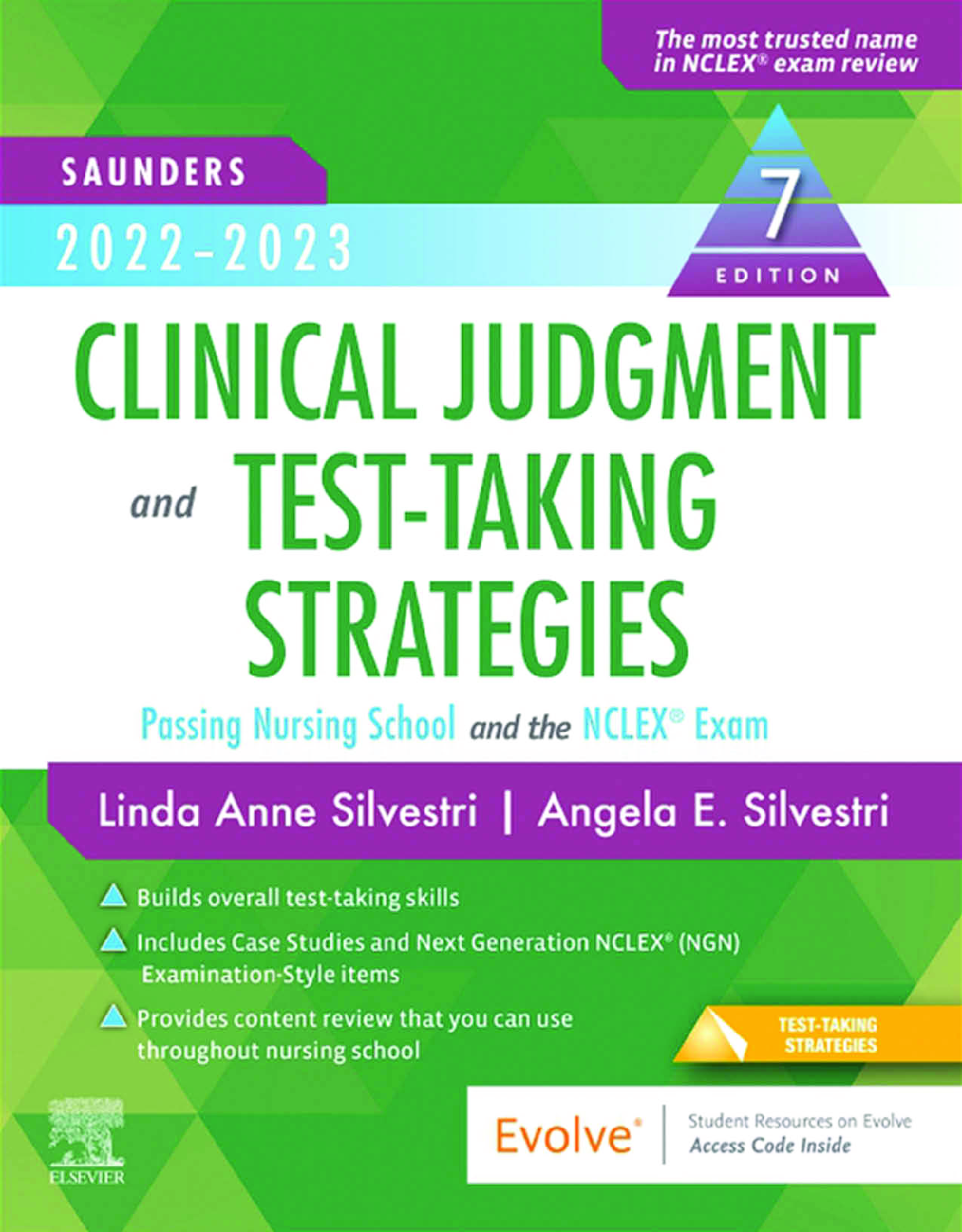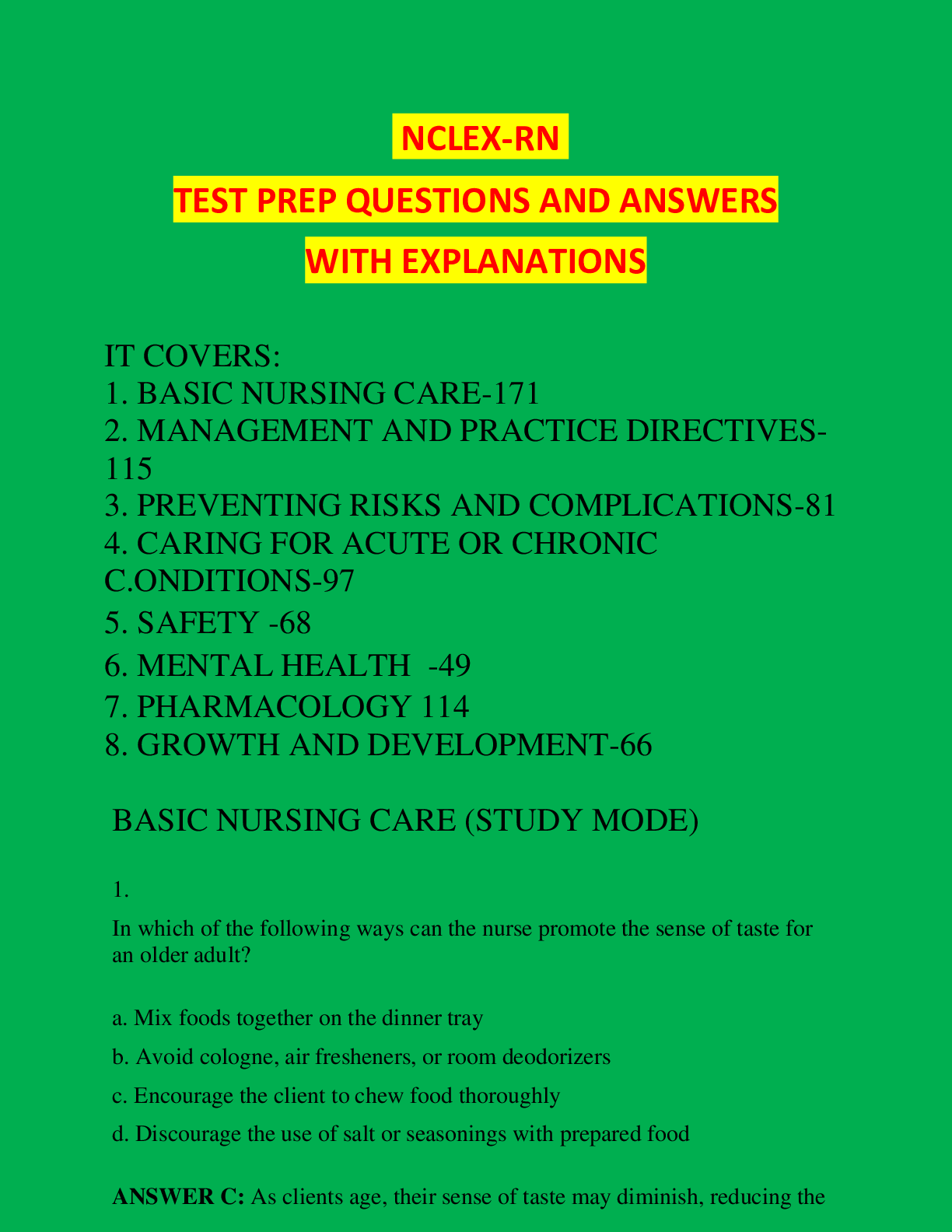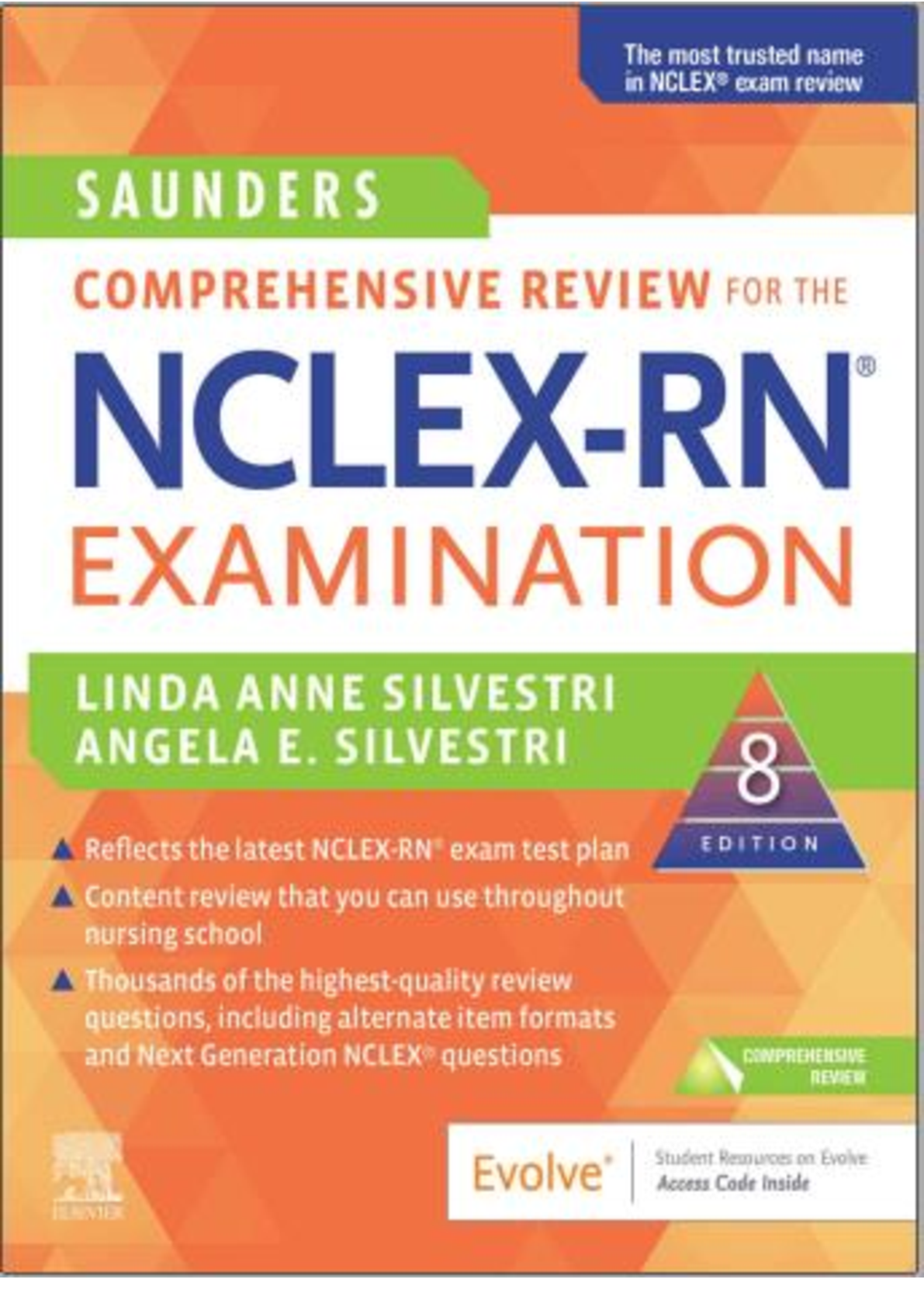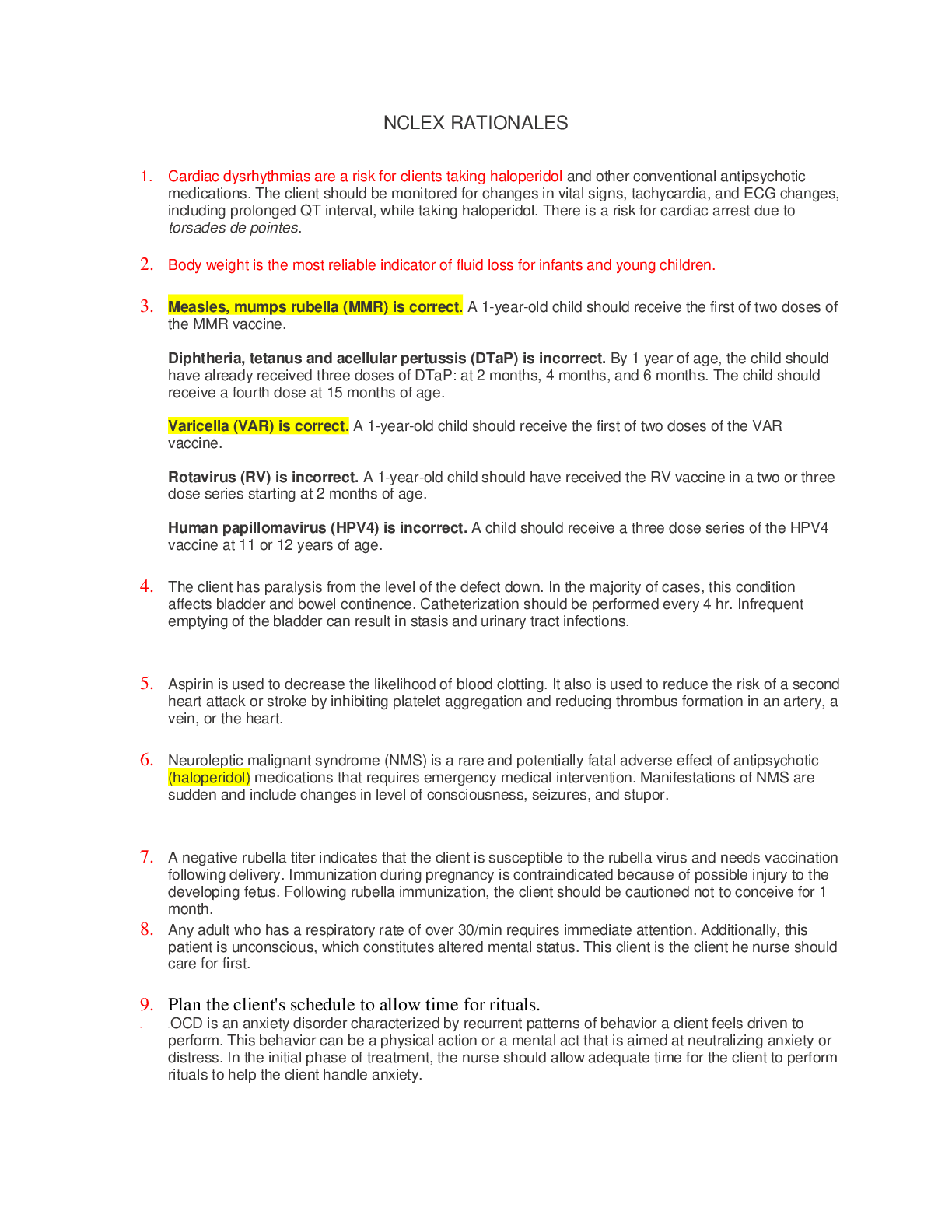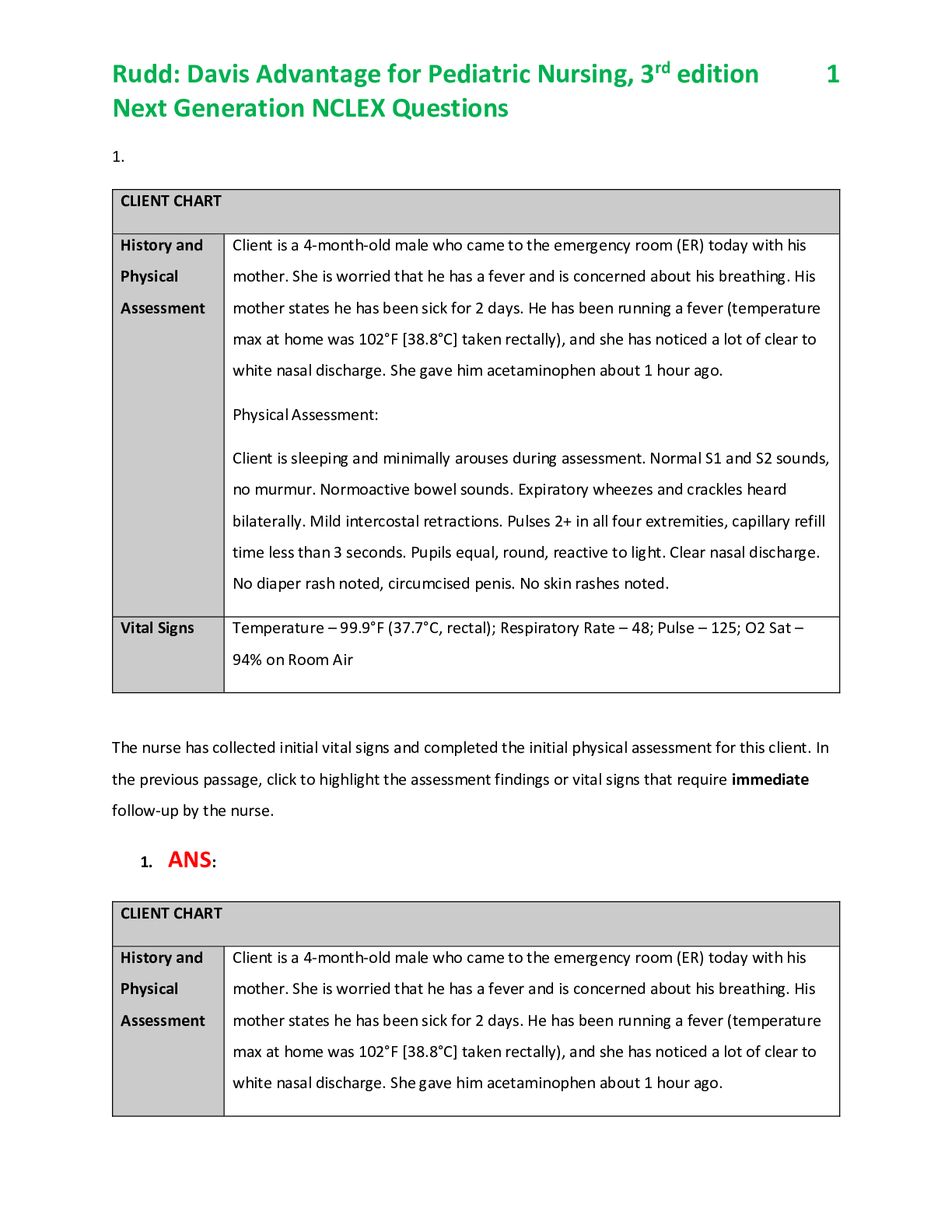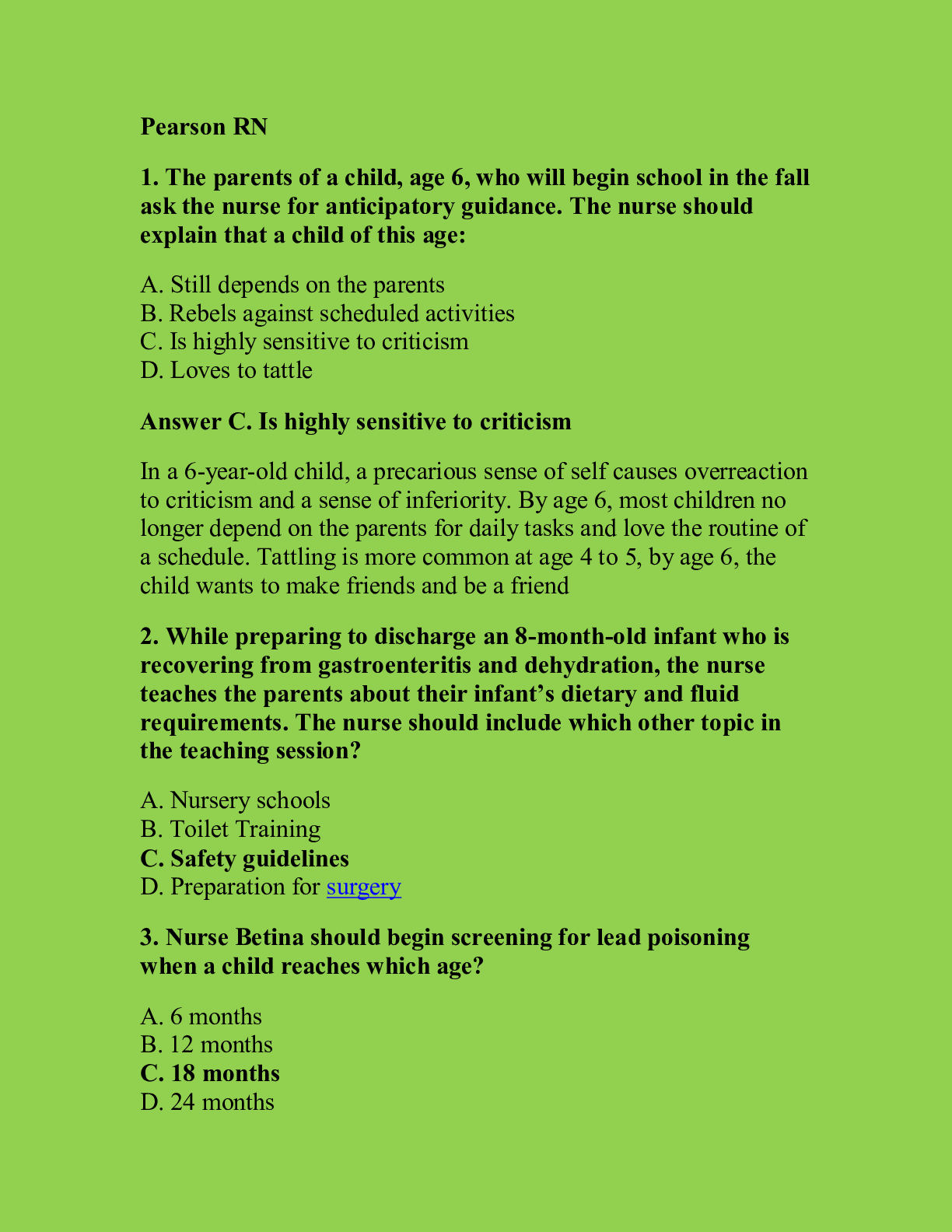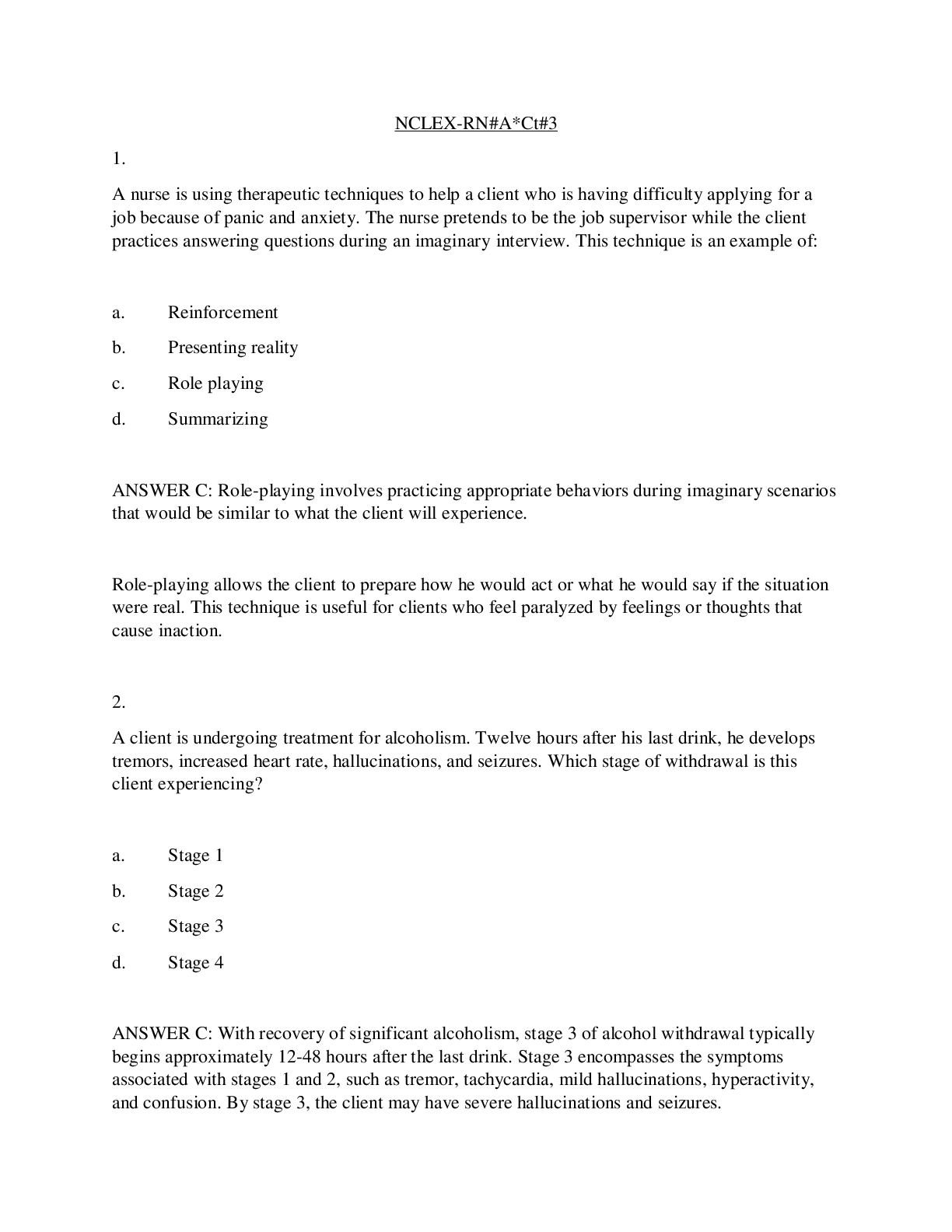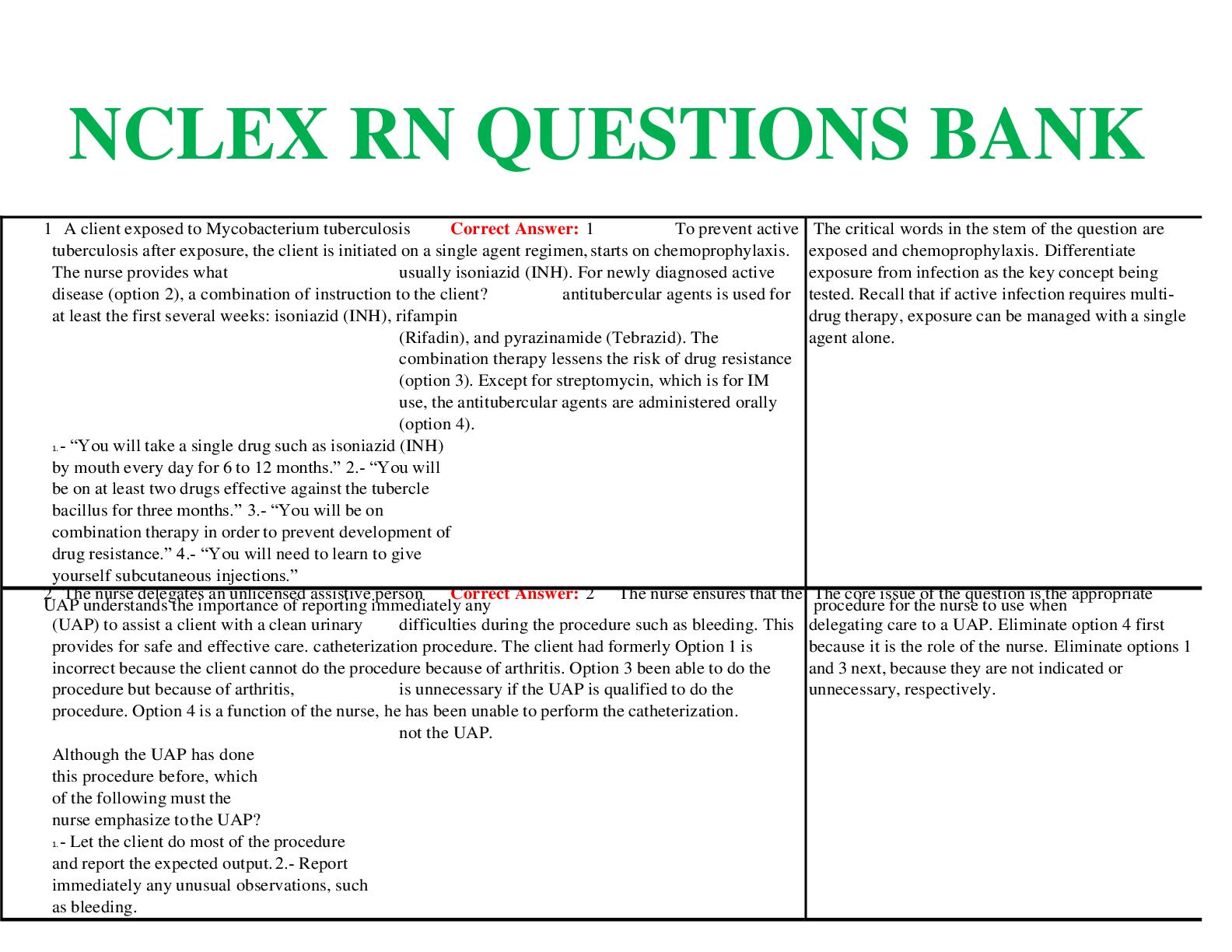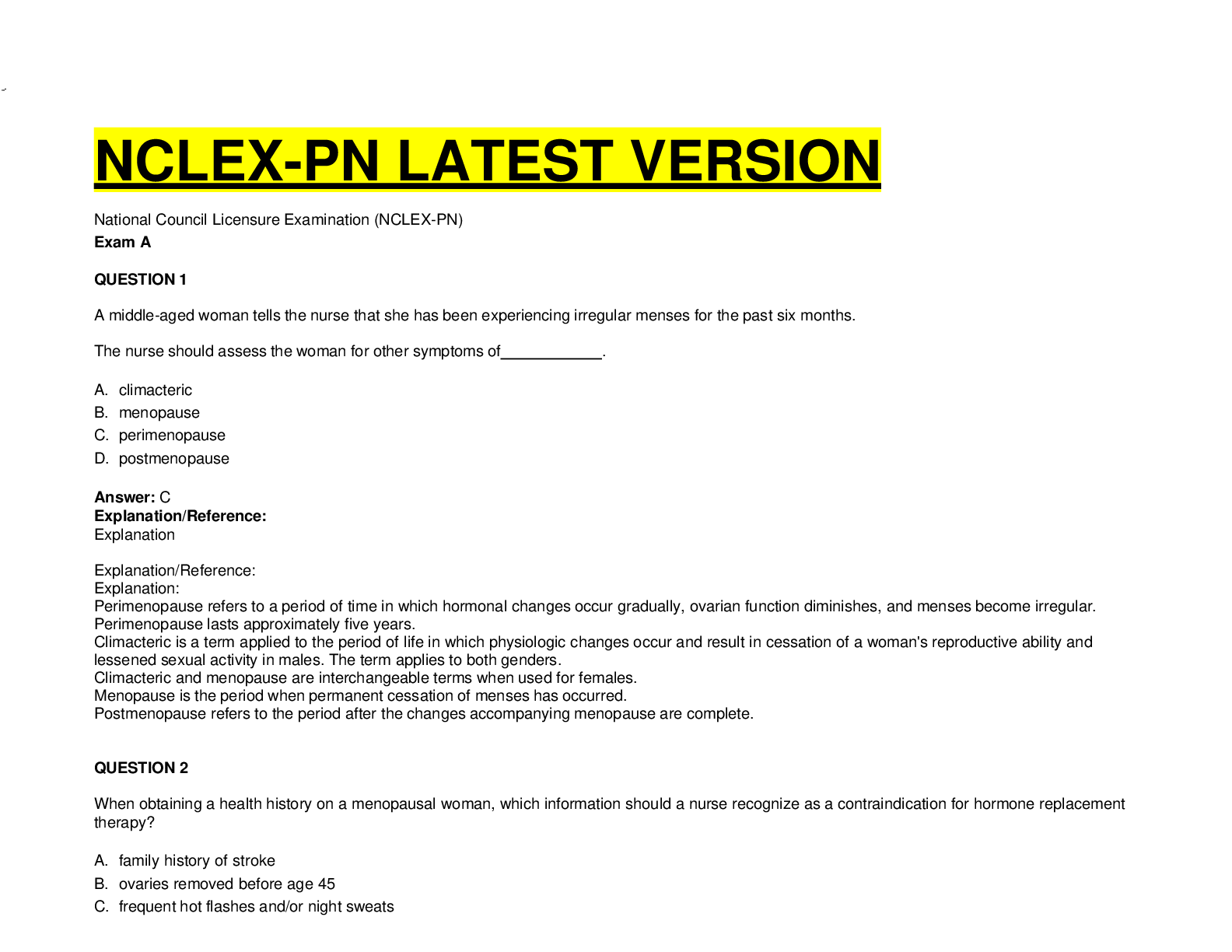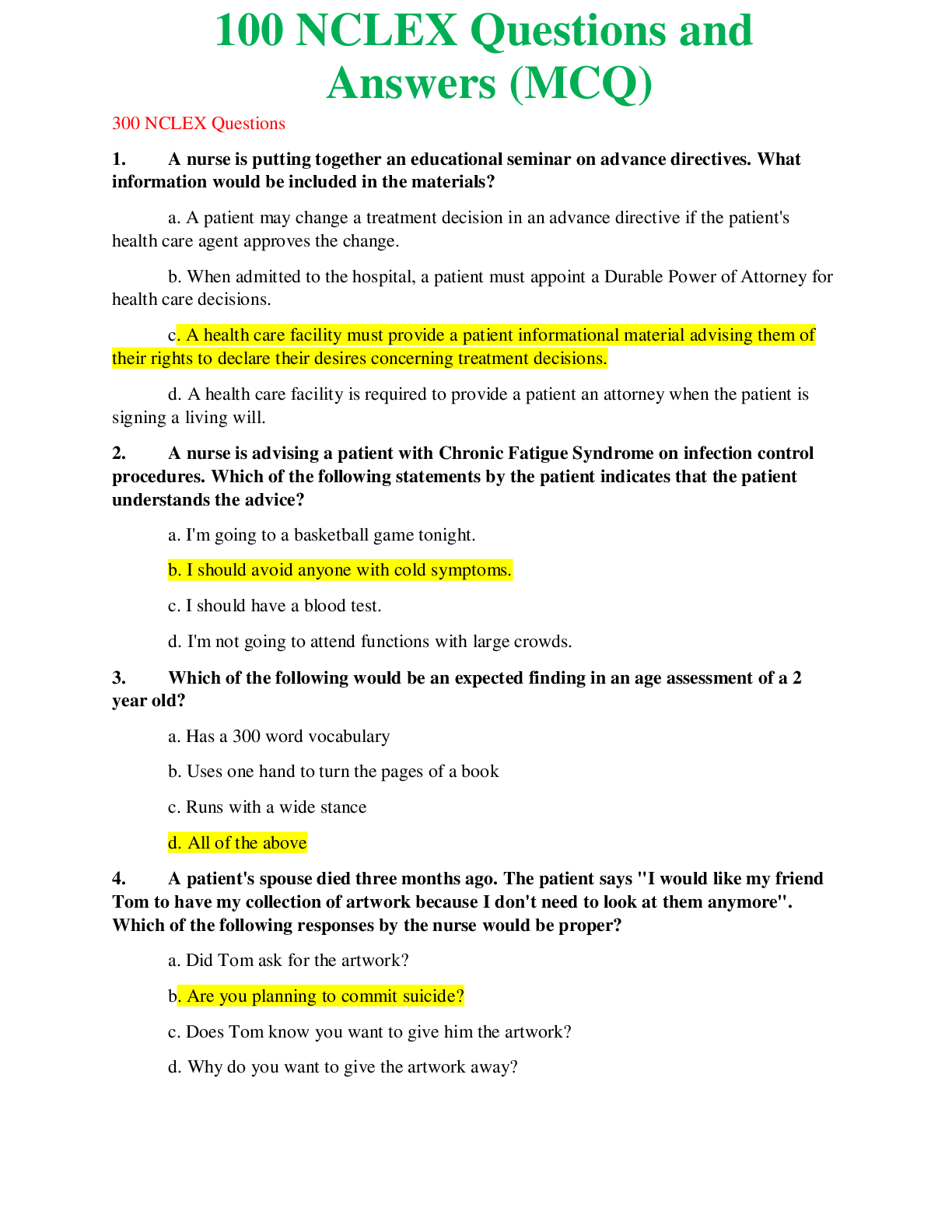*NURSING > NCLEX > NCLEX Review About The Aging Eye (study Guide with reviewed Questions and answers) (All)
NCLEX Review About The Aging Eye (study Guide with reviewed Questions and answers)
Document Content and Description Below
NCLEX Review About The Aging Eye (1-6) NCLEX Review About The Aging Eye Situation: Mang Tomas is a 60 year old man who has just had cataract surgery performed on his right eye. 1. The physicia... n has prescribed Cyclogel preoperatively to: a) prevent dryness of the cornea and conjunctiva b) reduce the inflammation of the iris and choroids c) paralyze the ciliary muscle d) promote drainage of aqueous humor from the chamber of the eye 2. After discharge, Mang Tomas attends the eye clinic for follow-up visits. When he receives his cataract glasses, it is important that the nurse advise him that: a) his peripheral vision will be increased b) objects will appear closer than they really are c) magnification by the lens is only about 10% d) daily eye drops are required with these lenses 3. The nurse should instruct a client preparing for eye surgery that which of these activities will be restricted post-operatively? a) bending with the knees flexed b) bending from the waist c) keeping the head in a neutral position d) lying flat 4. Nursing care for Mang Tomas during the first 48 hours after surgery will include: a) maintain bed rest b) changing the dressing daily c) encouraging coughing and deep breathing d) lie on the unoperated side Situation: Mang Ben is diagnosed with glaucoma and is scheduled for surgery. 5. Which symptoms are associated with acute closed-angle glaucoma? a) diplopia and photophobia b) episodic blindness and no pain c) blurred vision and colored rings around lights d) sensation of curtain drawn across the visual field 6. Which order for Mang Ben before surgery will the nurse question: a) demerol (meperidine) 50 mg IM b) atropine sulfate 0.4 mg IM c) valium (diazepam) 2 mg IM d) phenergan (promethazine) 25 mg IM NCLEX Review About The Aging Eye NCLEX Review About The Aging Eye (ANSWERS AND RATIONALE AFTER EVERY 5 QUESTIOS) 1. A physician prescribes "patching" for a child with strabismus of the right eye. A nurse instructs the mother regarding this procedure. Which of the following statements when made by the mother indicates that she understands the instruction? a) I will place the patch on the right eye b) I will place the patch on both eyes c) I will place the patch on the left eye d) I will alternate the patch from right to left eye hourly 2. The client comments, "I frequently change my eye glasses, none of which is satisfactory and I have difficulty focusing on my work." Which of the following disorders may the client be experiencing? a) cataract b) glaucoma c) detached retina d) myopia 3. An 85-year old woman complains of pain in her operated eye after cataract removal surgery. The nurse knows that this symptoms is a) expected, and she should offer analgesic b) unexpected and may signify a detached retina c) unexpected and may indicate hemorrhage d) expected and she should advise the client to be on bed rest 4. The client had just undergone repair of detached retina. Which of the following should be included in the nursing care plan of the client? a) encourage self-care activities b) limit movement of his eyes c) restrict excessive talking d) limit fluid intake 5. Which of the following is an effective technique of communicating with a hearing impaired client? a) speak slowly in a low tone of voice b) speak slowly in a loud voice c) speak slowly and try to overemphasize words d) speak slowly and directly in front of the client 6. Which of the following client statements indicates the need to postpone cataract surgery in the morning? a) this seasonal allergy should no be a problem b) the medications instilled into my eyes make my vision blurred c) I feel nervous with my operation tomorrow d) I have allergy to certain medications 7. Which of the following is done when performing Weber test? a) place vibrating tuning fork in front of the opening of the ear b) place the vibrating tuning fork in the middle of the head c) place the vibrating tuning fork behind the ear d) irrigate the ear with cold water and observe movement of the eyes 8. The client has been diagnosed to have Meniere's disease. Which of the following should be included when giving health teachings? a) limit carbohydrates and proteins in the diet b) limit salt intake c) limit fats in the diet d) drink a lot of fluids 9. The nurse plans care for a client with acute glaucoma who reports severe pain in the eyes and rainbow colors (halos) around lights. Which action should the nurse take first? a) administer pain medication b) explain to the client that with reduction in intraocular pressure, pain and other symptoms will subside c) provide preoperative teachings to the client d) assess the client's visual status 10. A nurse is providing instructions to a client and the family regarding home care after right eye cataract removal. Which statement by the client would indicate an understanding of the instructions? a) I will not sleep on my left side b) I will not sleep on my right side c) I will not sleep with my head elevated d) I will not wear my glasses until my physician says it is okay 11. A day care nurse is observing a 2-year old child and suspects that the child may have strabismus. Which observation made by the nurse might indicate this condition? a) the child has difficulty b) the child consistently tills the head to see c) the child consistently turns the head to see d) the child does not respond when spoken to 12. The mother of a 6-year old child arrives at a clinic because the child has been experiencing scratchy, red, and swollen eyes. The nurse notes a discharge from the eyes and sends a culture to the laboratory for analysis. Chlamydial conjunctivitis is diagnosed. Based on this diagnosis, the nurse determines that which of the following requires further investigation? a) possible trauma b) possible sexual abuse c) presence of an allergy d) presence of a respiratory infection 13. A nurse prepares a teaching plan for a mother of a child diagnosed with bacterial conjunctivitis. Which of the following, if stated by the mother, indicates a need for further teaching? a) I need to wash my hands frequently b) I need to clean the eye as prescribed c) it is okay to share towels and washcloths d) I need to give the eye drops as prescribed 14. A nurse provides discharge instructions to the mother of a child after myringotomy with insertion of tympanostomy tubes. The nurse determines that the mother needs additional instructions if the mother states that: a) swimming in deep water is prohibited b) swimming in lake water needs to be avoided c) she will place earplugs in the child's ears during baths and showers d) she will be sure to give her child soft tissues to blow his nose 15. Shortly after a neonate is delivered, erythromycin is instilled into the neonate’s eyes. This drug is given to prevent: a. Ophthalmia neonatorum b. Retrolental fibroplasias c. Corneal keratitis d. Acute uveitis 16. An older female client confides to the visiting nurse that she is afraid she will fall while going to the bathroom at night. Which suggestion, if made by the nurse, indicates that the nurse understands the visual changes affecting the older client? a) limit your fluid intake during the day b) use a commode in your bedroom at night c) keep a red light on the bathroom at night d) us ea bell to call your daughter if you need to get up 17. The nurse is developing a plan of care for the client scheduled for cataract surgery. The nurse documents which most appropriate nursing diagnosis in the plan of care? a) anxiety b) self-care deficit c) nutrition, imbalanced d0 sensory perception, disturbed 18. The nurse is performing an assessment on a client with a suspected diagnosis of cataract. The chief clinical manifestation that the nurse would expect to note in the early stages of cataract formation is: a) diplopia b) eye pain c) floating spots d) blurred vision 19. In preparation for cataract surgery, the nurse is to administer prescribed eye drops. The nurse reviews the physician's orders, expecting which type of eye drops to be prescribed? a) a miotic agent b) a thiazide diuretic c) an osmotic diuretic d) an mydriatic medication 20. During the early postoperative period, the client who has had a cataract extraction complains of nausea and severe eye pain over the operative site. The initial nursing action is to: a) call the physician b) reassure the client that this is normal c) turn the client on his or her operative side d) administer the ordered pain medication and anti-emetic 21. The client is being discharged from the ambulatory care unit following cataract removal. The nurse provides instructions regarding home care. Which of the following, if stated by the client, indicates an understanding of the instructions? a) I will take aspirin if I have any discomfort b) I will sleep on the side that I was operated on c) I will not lift anything if weighs more than 10 pounds d) I will wear my eye shield at night and my glasses during the day 22. The client with glaucoma asks the nurse if complete vision will return. The most appropriate response is: a) your vision will never return to normal b) your vision will return soon as the medication begins to work c) your vision loss is temporary and will return in about 3 to 4 weeks d) although some vision has been lost and cannot be restored, further loss may be prevented by adhering to the treatment plan 23. The nurse is developing a teaching plan for the client with glaucoma. Which of the following instructions would the nurse include in the plan of care? a) avoid overuse of the eyes b) decrease the amount of salt in the diet c) eye medications will need to be administered for the client's entire life d) decrease fluid intake to control the intraocular pressure 24. The nurse is preforming an admission assessment on a client with a diagnosis of detached retina. Which of the following is associated with this eye disorder? a) total loss of vision' b) pain in the affected eye c) a yellow discoloration of hte sclera d) a sense of a curtain falling across the field of vision 25. The nurse is caring for a client with a diagnosis of detached retina. Which assessment sign would indicate that bleeding has occurred as a result of the retinal detachment? a) total loss of vision b) a reddened conjunctiva c) a sudden sharp pain in the eye d) complaints of a burst of black spots or floaters 26. The client arrives in the emergency room following an automobile accident. The client's forehead hit the steering wheel and a hyphema is diagnosed. The nurse places the client in which position? a) flat on bed rest b) semi-fowler's on bed rest c) lateral on the affected side d) lateral on the unaffected side 27. The client sustains a contusion of the eyeball following a traumatic injury with a blunt object. Which intervention is initiated immediately? a) notify the physician b) apply ice to the affected eye c) irrigate the eye with cool water d) accompany the client to the emergency room 28. The client arrives in the emergency room with a penetrating eye injury from wood chips that occurred while cutting wood. The nurse assesses the eye and notes a piece of wood protruding form the eye. What is the initial nursing action? a) apply an eye patch b) perform visual acuity tests c) irrigate the eye with sterile saline d) remove the piece of wood using a sterile eye clamp 29. The client arrives in the emergency room after sustaining a chemical eye injury from a splash of battery acid. The initial nursing action is to: a) begin visual acuity testing b) cover the eye with a pressure patch c) swab the eye with antibiotic ointment d) irrigate the eye with sterile normal saline 30. The nurse is caring for a client following enucleation. The nurse notes the presence of bright red drainage on the dressing. Which nursing action is appropriate? a) notify the physician b) document the finding c) continue to monitor the drainage d) mark the drainage on the dressing and monitor for any increase in bleeding 31. A 55-year old woman was working in her garden. She accidentally sprayed insecticide into her right eye. She calls the emergency room frantic and screaming for help. The nurse should instruct the woman to take which immediate action? a) call the physician b) irrigate the eyes with water c) come to the emergency room d) irrigate the eyes with diluted hydrogen peroxide 32. The clinic nurse is preparing to test the visual acuity of a client using a Snellen chart. Which of the following identifies the accurate procedure for this visual acuity test? a) the right eye is tested, followed by the left eye, and then both eyes are tested b) both eyes are assessed together, followed by the assessment of the right and the left eyes c) the client is asked to stand at a distance of 40 feet from the chart and asked to read the largest line in the chart d) the client is asked to stand at a distance of 40 feet from the chart and read the line that can be read 200 feet away by an individual with unimpaired vision 33. The client's vision is tested with a Snellen chart. The results of the tests are documented as 20/60. The nurse interprets this as: a) the client is legally blind b) the client's vision is normal c) the client can read at distance of 60 feet what a client with normal vision can read at 20 feet d) the client can read only at distance of 20 feet what a client with normal vision can read at 60 feet 34. The clinic nurse notes that following several eye examinations, the physician has documented a diagnosis of legal blindness in the client's chart. The nurse reviews the results of the Snellen chart test expecting note which finding? a) 20/20 vision b) 20/40 vision c) 20/60 vision d) 20/200 vision 35. Tonometry is performed on the client with a suspected diagnosis of glaucoma. The nurse analyzes the test results as documented in the client's chart and understands that the normal intraocular pressure is: a) 2 to 7 mm Hg b) 10 to 21 mm Hg c) 22 to 30 mm Hg d) 31 to 35 mm Hg 36. The nurse is preparing a teaching plan for a client who is undergoing cataract extraction with intraocular implantation. Which home care measures will the nurse include in the plan? Select all that apply a) avoid activities that require bending over b) contact the surgeon if eye scratchiness occurs c) place an eye shield on the surgical eye at bedtime d) episodes of sudden severe pain in the eye are expected e) contact the surgeon if a decrease in visual acuity occurs f) take acetaminophen (Tylenol) for minor eye discomfort 37. The client is receiving an eye drop and eye ointment to the right eye. The nurse should: a) administer the eye drop first, followed by the eye ointment b) administer the eye ointment first, followed by the eye drop c) administer the eye drop, wait 10 minutes, and administer the eye ointment d) administer the eye ointment, wait 10 minutes, and administer the eye drop 38. The nurse is caring for a client with glaucoma. Which of the following medications, if prescribed for the client, would the nurse question? a) carbachol (Carboptic) b) atropine sulfate (Isopto Atropine) c) pilocarpine (Ocusert Pilo-20, Ocusert Pilo-40) d) pilocarpine hydrochloride (Isopto Carpine) 39. A miotic medication has been prescribed for the client with glaucoma. The client asks the nurse about the purpose of the medication. The nurse tells the client that: a) the medication will help dilate the eye to prevent pressure from occurring b) the medication will relax the muscles of the eyes and prevent blurred vision c) the medication causes the pupil to constrict and will lower the pressure in the eye d) the medication will help block the responses that are sent to the muscles in the eye 40. Pilocarpine hydrochloride (Isopto Carpine) is prescribed for the client with glaucoma. Which of the following medications does the nurse plan to have available in case of systemic toxicity? a) atropine sulfate b) pindolol (Visken) c) protamine sulfate d) naloxone hydrochloride (Narcan) 41. Betaxolol hydrochloride (Betoptic) eye drops have been prescribed for the client with glaucoma. Which of the following nursing actions is most appropriate related to monitoring for the side effects of this medication? a) monitoring temperature b) monitoring blood pressure c) assessing peripheral pulses d) assessing blood glucose level 42. In preparation for cataract surgery, the nurse to administer cyclopentolate (Cyclogyl) eye drops. The nurse a is to administer the eye drops, knowing that the purpose of this medication is to: a) produce miosis of the operative eye b) dilate the pupil of the operative eye c) provide lubrication to the operative eye d) constrict the pupil of the operative eye 43. The home health nurse visits a client at home and instructs the client on the administration of the prescribed eye drops. Which of the following statements by the client indicates a need for further education? a) I can lie down, pull up the upper lid, and place the drop in the lower lid b) I can lie down, pull down on the lower lid, and place the drop in the lower lid c) I can sit and tilt my head back, pull down on the lower lid, and place the drop in the lower lid d) I can lie on my side opposite to the eye I am going to place the drop, put the drop in the corner of the lid nearest my nose, and then slowly turn to my other side while blinking 44. The nurse is providing instructions to a client who will be self-administering eye drops. To minimize the systemic effects that eye drops can produce, the nurse instructs the client to: a) eat before instilling the drops b) swallow several times after instilling the drops c) blink vigorously to encourage tearing after instilling the drops d) occlude the nasolacrimal duct with a finger over the inner canthus for 30 to 60 seconds after instilling the drops 45. The nurse has an order to administer two opthalmic medications to the client who has undergone eye surgery. The nurse waits how many minutes after administering the first medication before giving the second? a) 1 to 2 b) 3 to 5 c) 8 to 10 d) it is not necessary to wait; the second medication can be administered immediately 46. The nurse is assigned to care for a client who has just undergone cataract surgery. The nurse plans to instruct the client that which of the following activities is permitted in the postoperative period? a) bending over b) lifting objects c) coughing exercises d) watching television 47. During a routine visit to the physician's office for monitoring of diabetic control, an older client with diabetes mellitus complains to the nurse of vision changes. The client describes blurring of vision with difficulty in reading and with driving at night. Given the history, the nurse interprets that the client is probably developing: a) cataracts b) glaucoma c) papilledema d) detached retina 48. A client arrives at the emergency room with a chemical burn of the left eye. The nurse immediately: a) applies a light bandage to the eye b) performs an assessment on the client c) applies a cold compress to the injured eye d) flushes the eye continuously with a sterile solution 49. The home care nurse visits an older client with arthritis. The client complains of difficulty instilling glaucoma eye drops because of shaking hands caused by the arthritis. Which instruction should the nurse plans to provide to the client to alleviate this problem? a) tilt the head back to instill the eye drops b) lie down on a bed or sofa to instill the eye drops c) a family member will have to instill the eye drops d) keep the eye drops in the refrigerator so that they will thicken and be easier to instill 50. A scleral buckling procedure is performed on a client with retinal detachment, and the nurse provides home-care instructions to the client. Which statement by the client indicates a need for further instructions? a) I need to avoid heavy lifting b) I need to avoid vigorous activity c) I need to wear an eye shield during naps and at night d) I need to clean the eye daily with sterile water ad a clean washcloth 51. The nurse is providing instructions to a client and family regarding home care after left-eye cataract removal. The nurse tells the client and family which of the following about positioning during the postoperative period? a) sleep only on the left side b) sleep on the right side or the back c) bend below the waist as often as you are able d) lower the head between the knees three times a day 52. A client has undergone surgery for glaucoma. The nurse provides which discharge instructions to the client? a) the sutures are removed after 1 week b) wound healing usually takes 12 weeks c) expect that vision will be permanently impaired d) a shield or eye patch should be worn to protect the eye 53. A client has undergone surgery for cataracts. The nurse instructs the client to call the physician for which of the following complaints? a) a sudden decrease in vision b) a gradual resolution of eye redness c) eye pain relieved by acetaminophen (Tylenol) d) small amounts of dried matter on the eyelashes after sleep 54. A client is seen in the health care clinic, and a diagnosis of conjunctivitis is made. The nurse provides instructions to the client regarding the care of the disorder while at home. Which statement by the client indicates the need for further instruction? a) I can use an ophthalmic analgesic ointment at night if I have eye discomfort b) I do not need to be concerned about spreading this infection to others in my family c) I should apply warm compresses before instilling antibiotic drops if purulent discharge is present in my eye d) I should perform a saline eye irrigation before instilling the antibiotic drops into my eye if purulent discharge is present 56. A client has undergone surgery for cataracts. The nurse instructs the client to call the physician if which of the following occurs? a) a sudden decrease in vision b) eye pain relieved by acetaminophen (Tylenol) c) small amounts of dried matter on the lashes after sleep d) gradual resolution of eye redness 57. A nurse is caring for a client with arthritis. The client complains of difficulty instilling glaucoma eye drops because of shaking hands caused by the arthritis. Which instruction would the nurse provide to the client to alleviate this problem? a) keep the drops in the refrigerator so they will thicken and be easier to instill b) lie down on a bed to instill the eye drops c) tilt the head straight back to instill the eye drops d) talk to the physician about the need for eye drops 58. Corrective glasses are prescribed for the client with bilateral aphakia, and the nurse provides instructions to the client regarding the use of the glasses. Which statement by the client indicates the need for further instructions? a) the glasses will correct my peripheral visual field of sight b) the glasses will magnify my central vision by 30% c) objects that I look at may be distorted d) it may be difficult to judge distances when I drive a car 59. A client is brought to the ambulatory care department by her spouse one day following a cataract extraction procedure and is diagnosed with hyphema that occurred as a result of the surgical procedure. The nurse provides which instruction to the client and spouse regarding treatment for the hyphema? a) resume normal activities because the hyphema will resolve on its own b) obtain assistance when ambulating c) return to the ambulatory care department for removal of the intraocular lens implant d) maintain bedrest and place an eye shield or patch over both eyes 60. A nursing student is caring for a client in the health care clinic who has been diagnosed with glaucoma. The nursing instructor asks the student to describe the type of medication that will likely be prescribed for the client to treat the eye disorder. Which statement by the student indicates an accurate understanding of the treatment for glaucoma? a) a miotic agent will lower the pressure in the eye and increase the blood flow to the retina b) a dilating agent will help dilate the eye to prevent pressure from occurring c) a cycloplegic will relax the muscles of the eyes and prevent blurred vision d) a mydriatic agent will help block the responses that are sent to muscles in the eye 61. A clinic nurse has provided instructions to a client with a diagnosis of glaucoma. Which statement by the client indicates an understanding of the treatment plan for glaucoma? a) I need to restrict my fluid intake to four glasses daily b) I need to take my eye drops for the rest of my life c) I can uses salt only for cooking d) I need to limit my amount of reading to 2 hours a day 62. A nurse is caring for a client with a diagnosis of retinal detachment. The client suddenly complains of a burst of black spots or floaters. The nurse interpret this symptom as: a) hemorrhage as a result of the detachment b) an expected finding c) the need to restrict fluids d) the need to patch the affected eye 63. A nurse is preparing a plan of care for a client being admitted to the hospital with a diagnosis of retinal detachment. Which of the following will the nurse include in the plan of care? a) out of bed to ambulate with assistance b) place an eye patch over the affected eye c) maintain high-fowler's position d) restrict visitors 64. A client arrives at the emergency department after a blow to the eye from a softball. The initial nursing action would be to: a) call a physician to perform a thorough eye examination b) irrigate the eye with sterile cool water c) place the client in a supine position on a stretcher d) apply ice to the affected eye 65. A nurse receives a telephone call from a neighbor, who tells the nurse that the spouse accidentally broke a mirror, and a piece of glass flew into the eye. The nurse arrives at the home and finds that a piece of glass is protruding from the victim's eye. The nurse should: a) remove the piece of glass using a tweezers that was boiled for sterilization purposes b) apply an eye patch and instruct the victim and spouse to report to the emergency department c) accompany the victim and spouse to the emergency department d) flush the eye thoroughly with tap water 66. A client arrives at the emergency department after an eye injury in which an acid used to clean the bricks on a fireplace splashed into his eye. The initial assessment question by the nurse is which of the following? a) did you bring the container of acid with you? b) what time did the injury occur? c) did you flush the eye following the injury? d) what type of acid caused the injury? 67. A nurse is caring for a client following enucleation. Which of the following assessment findings would indicate the need to notify the physician? a) bright red drainage on the dressing b) a respiratory rate of 22 breaths per minute c) complaints of pain in the affected eye d) a blood pressure of 138/88 mm Hg 68. A client is being discharged from the ambulatory care unit after cataract removal, and the nurse provides instructions regarding home care. Which of the following should the nurse tell the client? a) take acetaminophen (Tylenol) if any discomfort occurs b) sleep on the side that was operated on to promote drainage c) avoid wearing glasses d) do not lift anything that weighs more than 20 pounds 69. An ambulatory care nurse provides instructions to a client after a cataract extraction. Which statement by the client indicates a need for further instructions? a) I need to avoid bending over to pick up items b) I will sleep on the unoperative side c) I need to wear an eye shield all the time d) There is no reason to stay on a special diet [Show More]
Last updated: 1 year ago
Preview 1 out of 16 pages
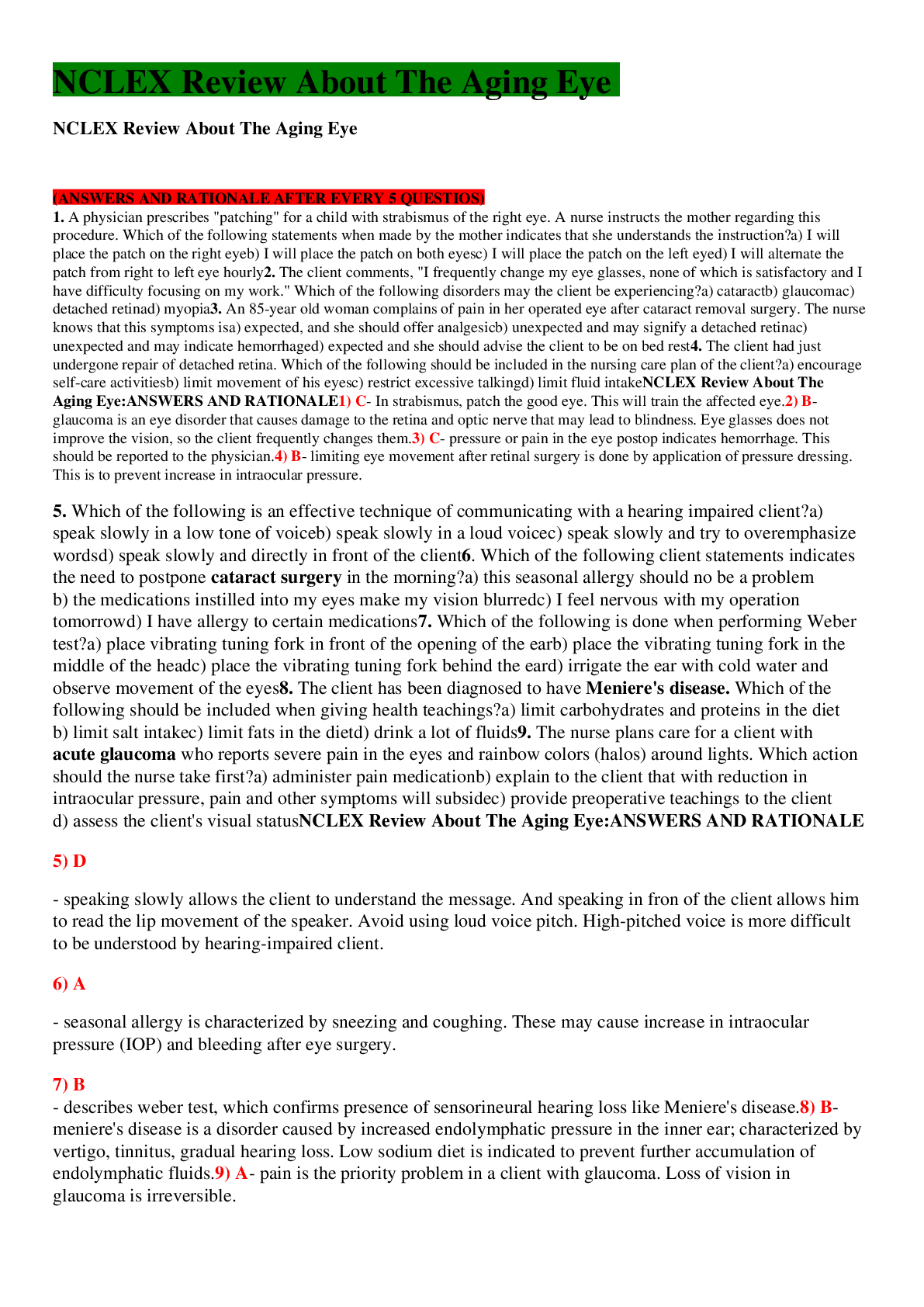
Reviews( 0 )
Document information
Connected school, study & course
About the document
Uploaded On
Nov 13, 2020
Number of pages
16
Written in
Additional information
This document has been written for:
Uploaded
Nov 13, 2020
Downloads
0
Views
75


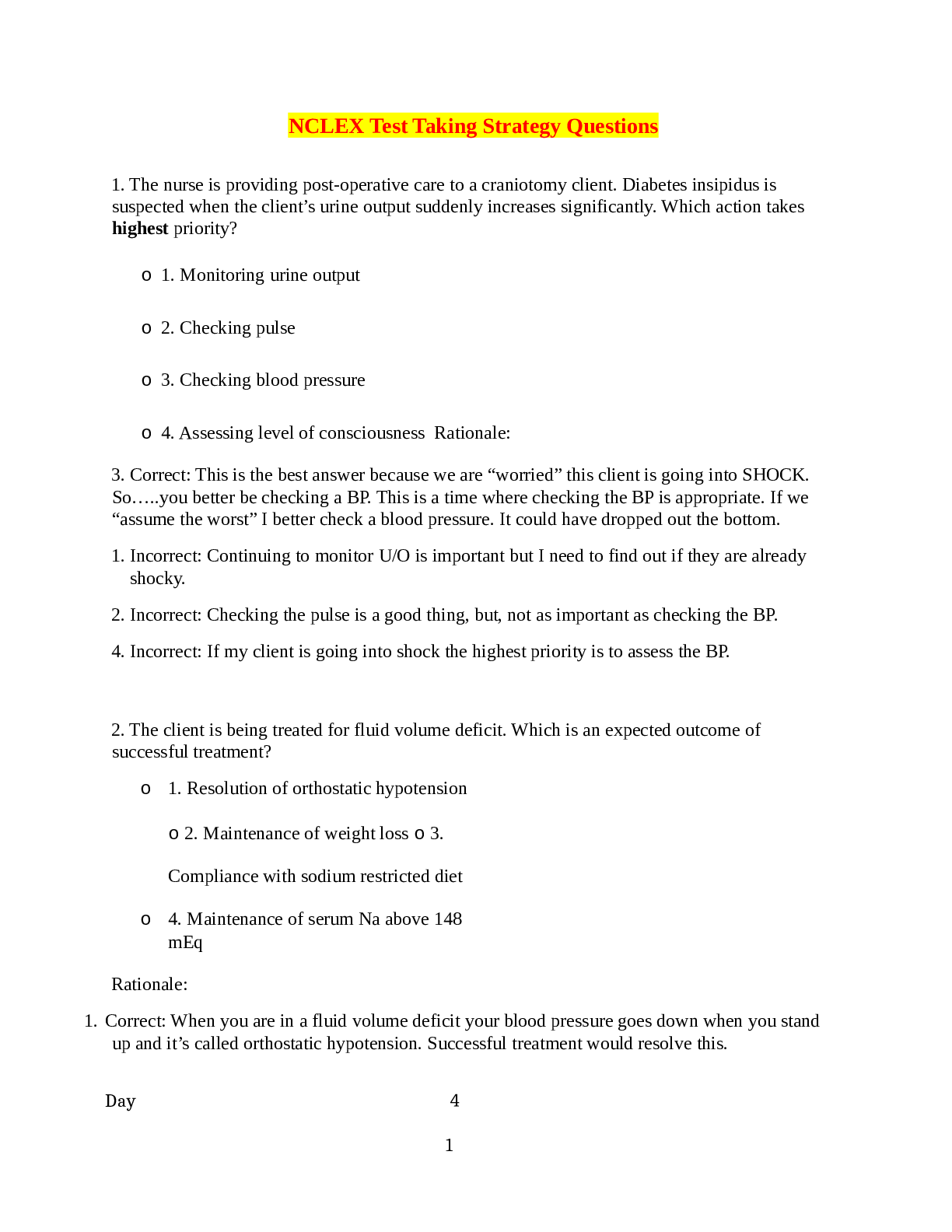

.png)
